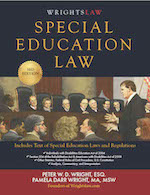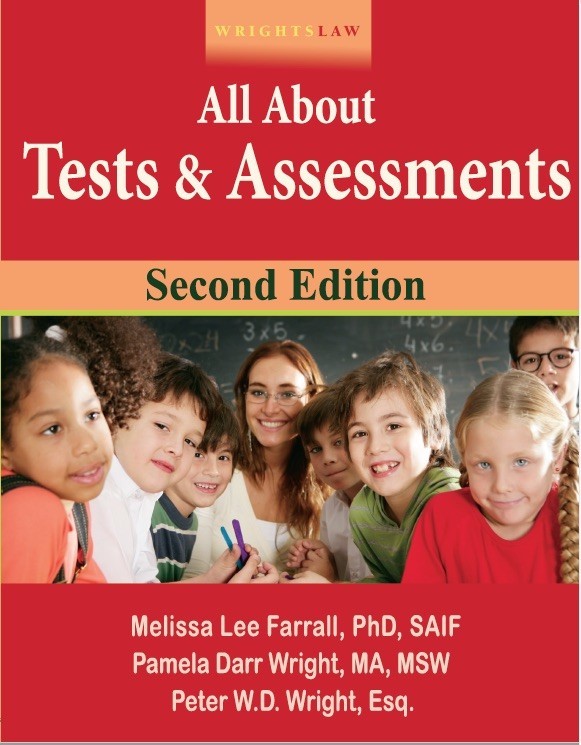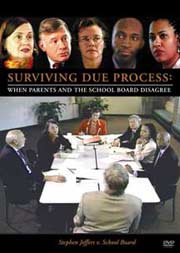 |
|
|
| Home > IDEA Regs Part C |
|
|
20 U.S.C. § 1414 - Evaluations, Eligibility, IEPs, & Placement The law about IEPs is in 20 U.S.C. § 1414 On this page, the text of the IDEA statute is in black. NOTE : Our book, Wrightslaw: Special Education Law, includes the full text of the Individuals with Disabilities Education Act, Section 504 of the Rehabilitation Act, FERPA, and a casebook of decisions in special education cases by the U. S. Supreme Court. Reviews TOC Orders (d) Individualized Education Programs.-- (1) Definitions.--As used in this title: (A) Individualized education program.--The term ‘individualized education program’ or ‘IEP’ means a written statement for each child with a disability that is developed, reviewed, and revised in accordance with this section and that includes--(i) a statement of the child’s present levels of educational performance, including--
(2)
Requirement that program be in effect.--
(A) In general.--At the beginning of each school year, each local educational agency, State educational agency, or other State agency, as the case may be, shall have in effect, for each child with a disability in its jurisdiction, an individualized education program, as defined in paragraph (1)(A).
(3)
Development of IEP.--
(A) In general.--In developing each child’s IEP, the IEP Team, subject to subparagraph (C), shall consider-- (i)
the strengths of the child and the concerns of the parents for
enhancing the education of their child; and
(ii) the results of the initial evaluation or most recent evaluation of the child. (PWDW
Note: It is mandatory. The IEP must consider the parents concerns
and the results of the most recent evaluation.)
(B)
Consideration of special factors.--The IEP Team shall-- (PWDW
Note: It is mandatory that the IEP team must consider positive
behavioral interventions to address the child’s behavior. If
this is not documented or considered by the school district,
it can cause the district significant legal problems. The interventions,
strategies and supports that are discussed and attempted should
be logged in. Parents should document the school’s failure to
consider and use such positive strategies and interventions.
Parents can accomplish this by using courteous thank you letters
or by developing a "Parent’s Attachment" to a proposed IEP that
they prepare and distribute at the IEP meeting. End PWDW
Note)
(ii)
in the case of a child with limited English proficiency,
consider the language needs of the child as such needs relate
to the child’s IEP;
(iii) in the case of a child who is blind or visually impaired, provide for instruction in Braille and the use of Braille unless the IEP Team determines, after an evaluation of the child’s reading and writing skills, needs, and appropriate reading and writing media (including an evaluation of the child’s future needs for instruction in Braille or the use of Braille), that instruction in Braille or the use of Braille is not appropriate for the child; (iv) consider the communication needs of the child, and in the case of a child who is deaf or hard of hearing, consider the child’s language and communication needs, opportunities for direct communications with peers and professional personnel in the child’s language and communication mode, academic level, and full range of needs, including opportunities for direct instruction in the child’s language and communication mode; and (PWDW
Note: Two areas of litigation are related to this part of
the statute. First, when children are hard of hearing or have
cochlear implants, parents and private sector professionals
often request of Auditory - Verbal Therapy, not sign language
or a "Total Communication" approach that blends sign language
and lip reading. The "Auditory Verbal" approach teaches listening
and speaking skills. These children often need to be taught
how to listen auditorily, instead of learning how to read lips
and read sign language. The child needs to learn how to speak,
using spoken speech, rather than using sign language and gestures.
The
second area of litigation relates to the use of Applied Behavioral
Analysis or Lovaas therapy to remediate children who have autism.
Without intensive intervention, most of these children become
very withdrawn. Until recently, many autistic children were
institutionalized. The Lovaas or ABA approach is very intense.
It is individualized one-to-one therapy for forty hours a week.
It teaches the child how to communicate. Research by Dr. Ivar
Lovaas and others shows that many autistic children can eventually
enter regular public school classroom programs, with no need
for special education. In the Fall of 1997, the National Institutes
of Health funded several research projects about educating and
remediating children who have autism. As information from these
research projects is available, we should see major shifts and
improvements in this area. LRP Publications recently reported
that parents are prevailing in nearly seventy percent of the
Lovaas ABA cases. (End of PWDW Note)
(v)
consider whether the child requires assistive technology devices
and services.
(C) Requirement with respect to regular education teacher.--The regular education teacher of the child, as a member of the IEP Team, shall, to the extent appropriate, participate in the development of the IEP of the child, including the determination of appropriate positive behavioral interventions and strategies and the determination of supplementary aids and services, program modifications, and support for school personnel consistent with paragraph (1)(A)(iii). (PWDW Note: This is mandatory, "to the extent appropriate." The regular ed teacher shall work to develop positive behavioral interventions. Special education is not a service or program that is limited to the special ed classroom at the end or the building, or in the trailer out back, but must include the participation of the regular education teacher. Despite their expected objections, they will have to become involved. Often, after a regular education teacher truly participates in the development of an IEP, they have a personal stake in the success of the IEP and are able to perceive the child in a different, more positive light. Too many regular education teachers are unaware of the child’s intellectual and educational strengths and weaknesses. They are not aware that despite a strength in one area that may be at a 95th percentile rank, the child’s processing speed may be at the 2nd percentile rank. End PWDW Note) (4)
Review and revision of IEP.--
(A) In general.--The local educational agency shall ensure that, subject to subparagraph (B), the IEP Team-- (i)
reviews the child’s IEP periodically, but not less than annually
to determine whether the annual goals for the child are being
achieved; and
(ii) revises the IEP as appropriate to address-- (I)
any lack of expected progress toward the annual goals and in
the general curriculum, where appropriate;
(II) the results of any reevaluation conducted under this section; (III) information about the child provided to, or by, the parents, as described in subsection (c)(1)(B); (IV) the child’s anticipated needs; or (V) other matters.
(5)
Failure to meet transition objectives.--If a participating agency,
other than the local educational agency, fails to provide the transition
services described in the IEP in accordance with paragraph (1)(A)(vii),
the local educational agency shall reconvene the IEP Team to identify
alternative strategies to meet the transition objectives for the
child set out in that program.
(6) Children with disabilities in adult prisons.-- (A) In general.--The following requirements do not apply to children with disabilities who are convicted as adults under State law and incarcerated in adult prisons: (i)
The requirements contained in section 612(a)(17) and paragraph
(1)(A)(v) of this subsection (relating to participation of children
with disabilities in general assessments).
(ii) The requirements of subclauses (I) and (II) of paragraph (1)(A)(vii) of this subsection (relating to transition planning and transition services), do not apply with respect to such children whose eligibility under this part will end, because of their age, before they will be released from prison. (B) Additional requirement.--If a child with a disability is convicted as an adult under State law and incarcerated in an adult prison, the child’s IEP team may modify the child’s IEP or placement notwithstanding the requirements of sections 612(a)(5)(A) and 614(d)(1)(A) if the State has demonstrated a bona fide security or compelling penological interest that cannot otherwise be accommodated. (e)
Construction.--Nothing in this section shall be construed to
require the IEP team to include information under one component
of a child’s IEP that is already contained under another component
of such IEP.
(f) Educational Placements.--Each local educational agency or State educational agency shall ensure that the parents of each child with a disability are members of any group that makes decisions on the educational placement of their child.
After IEP meetings, it is good practice to write courteous thank you letters. You can express your concerns about your child’s program, progress, etc. Parents should assume that if they request a special education due process hearing, testimony from all school staff would be adverse to their child. Parents often hear testimony that they agreed to everything in the IEP and had never expressed any concerns about the program. Of course, the parent’s testimony is usually the opposite. Having a transcript is good protection for the parents and school officials. The process of recording and transcribing can help cause lengthy, time consuming meetings to be much more focused and efficient. For purposes of case preparation, parents must assume that they cannot testify. Parents must have independent evidence that supports their position. Parents must also have a "paper trail" of courteous correspondence with school officials. Parents must learn to analyze educational progress and educational regression. This means that parents must understand psychological and educational tests. See our articles about IEPs and "Understanding Tests and Measurements" at our website: https://www.wrightslaw.com/. After parents read these articles and evaluate their child’s test scores, most are astounded to learn that their child fell further behind the peer group in the area of the identified deficiency, while the child was receiving special education services! End of PWDW Note)
|
|||||||||||||||||||||||




